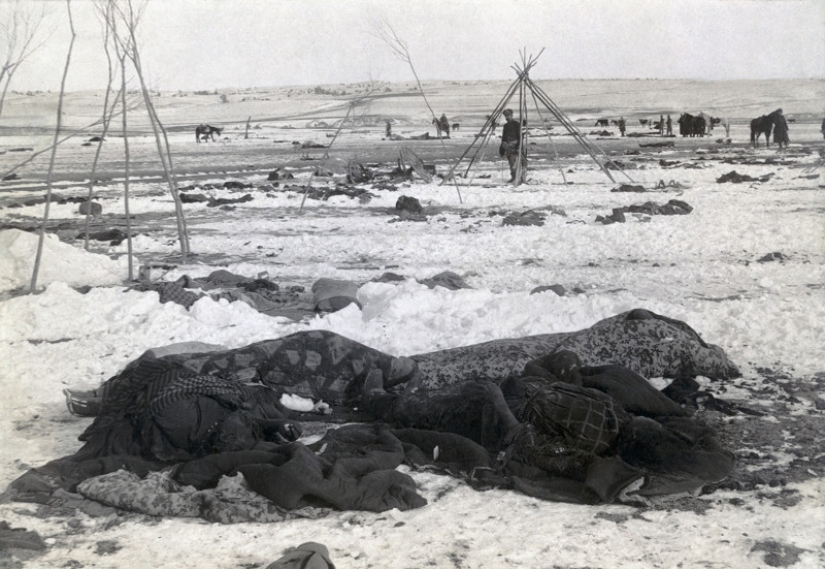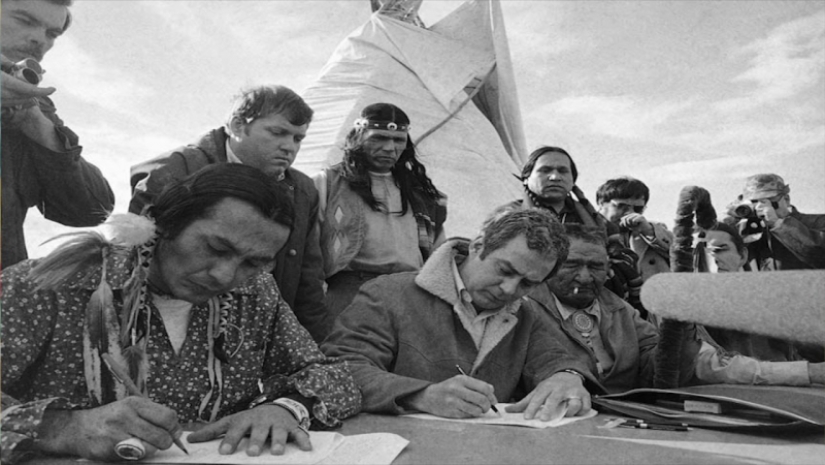The confrontation at wounded knee: in 1973, Indians of the United States last time went on a "warpath"
Categories: Conflict | History | Nations | North America
By Pictolic https://pictolic.com/article/the-confrontation-at-wounded-knee-in-1973-indians-of-the-united-states-last-time-went-on-a-warpath.htmlOn the morning of February 27, 1973, in the settlement of wounded knee, located on an Indian reservation at pine ridge, arrived several hundred armed Indians. The village, inhabited by 40 people, was captured by the activists of the American Indian. It was the last in the history of US armed conflict "Redskins" and "palefaces". It lasted 71 days.

For the Lakota, related to the linguistic family of the Sioux, wounded knee is an iconic place and a symbol of crimes against their people. Here in 1890 cavalry regiment of the US army staged a massacre that killed 300 Indians. Most of the dead women and children, but "pale" victory had cost 25 dead.

The bodies of the Indians killed in the massacre of 1890
By 1973, wounded knee became a settlement with 40 inhabitants. He was on the RES at pine ridge, where he lived 14 thousand Indians. The main problems of the indigenous people was crime, alcoholism, unemployment, high infant mortality is 5 times higher than the U.S. as a whole.
There were rumors that pharmaceutical companies conduct experiments on Indian children. The Lakota belonged to only half of the land reservations, and the rest of the territory seized by the Federal government, as it discovered deposits of uranium.

The only thing that was needed by the residents, the churches that were built on Federal funds. All of them acted 137, one for every 100 inhabitants of the reservation. The real problem was corruption in the face of a tribal leader dick Wilson.
On the night of 27 February 1973, a convoy of 200 vehicles entered the territory of the reservation. The machines were activists of the radical organization "Movement of the American Indians" (DAI), which profits to offset thieving leader and tribal Council cooperating with the Federal authorities.
Supervised the landing of Dennis banks and Russell means. Subsequently, the means will be in a movie and its main work will be the role of Chingachgook in the 1992 tape "Last of the Mohicans".

Leaders of the uprising, Russell means (left) and Dennis banks speak to reporters
To deal with the leader failed and DAI decided to go to drastic measures. On 28 February the police of South Dakota, it was reported that in wounded knee, unknown robbed the store, digging trenches around the Church on the hill and holding 11 hostages who appeared to have joined voluntarily.
The Indians announced the establishment of the tribal government free from the power of the "white man". They also demanded the revision of the treaties between indigenous peoples and the government of the United States.
In an interview with Newsweek Russell means said, "the government has two choices, either to attack and destroy us, as it was in 1890, or to consider our reasonable demands."

The common picture of the instigators of the uprising
In the presentation took part more than 300 people, among which was how visitors, and local residents – men, women, children and the elderly. Armed rebels were revolvers, shotguns, some rifles with optics and one AK.
Like their ancestors, overlooking the "warpath", the Indians painted their faces with paint, and tied on the head of the traditional red tape. The support base for the rebels was a stone Church on the site of a mass grave of victims of the 1890.

The evening of 28 February, the town was blocked by police squads and the FBI. As government forces joined leader dick Wilson, who called the rebels "tool of the Communists" and "costumed clowns" and his men launched a real terror. They burned houses, raided and severely beat seen in connection with the Means of the Indians.
Between the Indians and the feds began to erupt skirmishes, and March 3 at a military base near the reservation, the chief of staff of the 82nd airborne division Volney Warner who decides to go to drastic measures. According to the recollections of tribal elders Harry Roland power pulled to the settlement armored vehicles and fired his heavy machine guns. April 26, in the shooting death of a Vietnam veteran and activist DAI Lakota buddy Lamont.

After getting into his trench tear gas grenades he climbed out of the shelter and landed under machine-gun fire. The following were killed Cherokee Frank Clearwater, who came to the reservation from North Carolina. 60 Indians were injured of varying severity.
The firefight intensified, the besieged were running out of water, food and ammunition. Help required 13 wounded. On may 2, the rebels and the White House entered into negotiations.
Photos taken during the fighting:

The U.S. government promised to discuss the issues concerning the Treaty of 1868 and to punish all who are residents of the reservation were accused of criminal actions against him. To keep the siege was no more sense, and after 71 days after the beginning of the conflict the reservation surrendered. During the skirmishes with the Lakota wounded two police officers.
May 9, 1973, the Indians left their positions. On the same day the delegates of the DAI and the chiefs of the Lakota gathered to discuss the issue with representatives of the White House.
However, instead of negotiations, the Indians received a letter from the assistant to President Nixon in which it was written: "the time of the conclusion of treaties with the Indians had passed in 1871, that is, 102 years ago. Only Congress can change the status quo". But the congressmen to hold hearings is not going to. Instead of negotiating the organizers of the uprising were arrested.

Russell means (left) and assistant U.S. attorney Kent Frizzell sign the armistice agreement
The trial lasted 4 months and due to public outcry and competent work of lawyers Mark lane and William Kunstler Indian leaders were acquitted. The verdict was affected by the illegal drying agents of the FBI phones and pressure on witnesses. From 1973 to 1975, 64 activist DAI is killed or imprisoned on trumped-up charges. And one of the leaders of the uprising Dennis banks had 10 years to hide underground. In 2007, a group of Lakota Indians renounced his U.S. citizenship and announced the creation of its unrecognized by any country.
In 1973, the last time the Indians took up arms. In our time, native Americans are fighting other methods. They served on the government in court, and actively use the media and human rights organizations, as well as beat authorities have additional benefits. However, modern Indians remember ancestors, they do not dissolve in a multinational population of the United States and preserve their identity.
Keywords: Indians | Guns | Revolution | USA
Post News ArticleRecent articles

A year before Madonna first appeared on television and confidently told American Bandstand host Dick Clark that she was going to ...

In a recent issue of sexual harassment on everyone's lips. Inappropriate and Intrusive signs of attention began to see around, even ...
Related articles

The period of the Civil war will forever remain in history as a time of anarchy, violence and destruction. This era has produced ...

Filmmaker Paul Ratner (Paul Ratner) revealed a passion for studying old photographs of Indians during the filming of the film ...

Step by step, decree by decree — at first you have a measured life, an apartment, savings and other property, and after a few ...

At first glance, it was an ordinary wedding, and even the priest of the San Jorge Church did not notice anything strange. But in ...